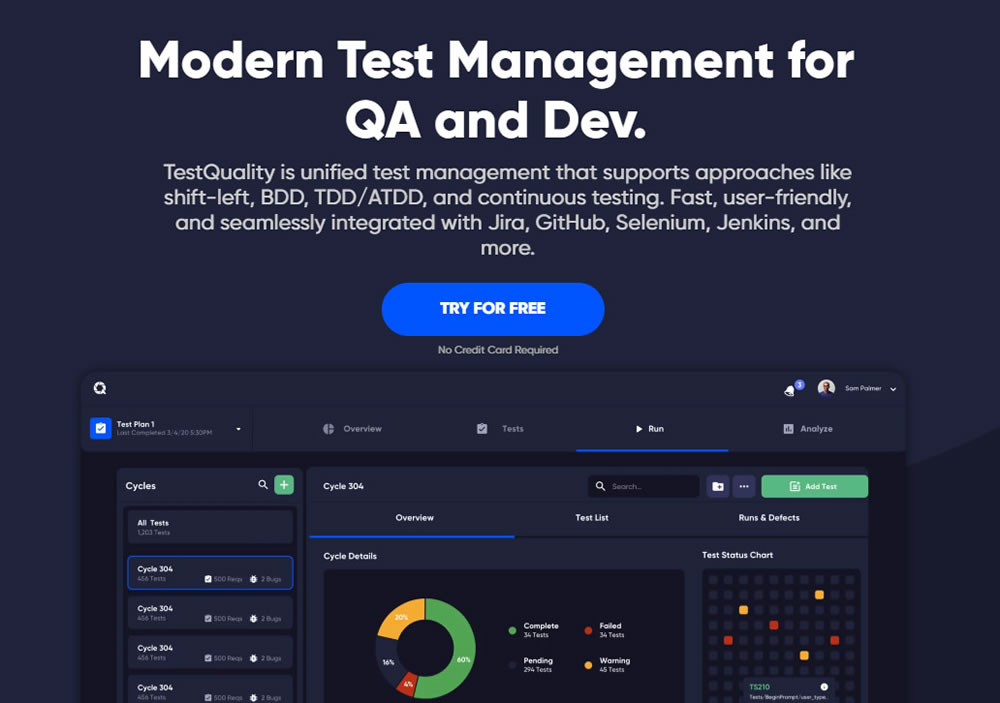When embarking on a software development project, a well-structured test plan is essential for ensuring the quality and reliability of the final product. A comprehensive test plan outlines the scope, approach, resources, and schedule for testing activities, serving as a blueprint for the testing process. In this blog post, we will delve into the key elements necessary to create a robust test plan template for software testing. Each section is designed to ensure thorough and efficient testing, aligned with the project's objectives and goals.
1. Introduction
The introduction of a test plan provides a brief overview of the project and the purpose of the testing activities. It sets the stage by explaining why the test plan is needed and what it aims to achieve. This section should include:
- Project Overview: A brief description of the software project, its scope, and its significance. Explain the project's objectives and the problems it aims to solve. This gives context to the testing activities and highlights the importance of thorough testing.
- Scope of Testing: Clearly define what will and will not be tested to set expectations and boundaries for the testing efforts. This helps prevent scope creep and ensures that the testing team remains focused on the critical aspects of the project. Specify the modules, functionalities, and features included in the testing scope, and identify those that are out of scope.
- Objectives and Goals: Outline the primary objectives and goals of the testing process, such as ensuring functionality, performance, and security of the software. Discuss how these objectives align with the overall project goals and how they contribute to delivering a high-quality product.

2. Test Items
This section lists the specific features, components, and interfaces that will be tested. It's crucial to maintain traceability to requirements to ensure all aspects of the software are covered. Include:
- Features and Components: Provide a detailed list of the software features and components to be tested. Break down the application into its core functionalities and components, and explain how each will be evaluated.
- Traceability to Requirements: Mapping of test items to the corresponding requirements to ensure coverage and accountability. This involves creating a requirements traceability matrix (RTM) that links test cases to specific requirements, ensuring that all requirements are addressed during testing. This traceability helps in identifying any missing test cases and ensures comprehensive coverage.

3. Test Approach
The test approach defines the overall strategy and methodology for testing. It encompasses:
- Testing Levels: Specify the levels of testing, such as unit testing, integration testing, system testing, and acceptance testing. Each level serves a different purpose and targets specific areas of the application. Describe the focus and objectives of each testing level.
- Unit Testing: Testing individual components or modules in isolation to ensure they function correctly.
- Integration Testing: Testing the interactions between integrated components to detect interface defects.
- System Testing: Testing the complete system as a whole to verify that it meets the specified requirements.
- Acceptance Testing: Testing to determine if the system meets the acceptance criteria and is ready for deployment.
- Testing Types: Describe the types of testing to be conducted, including functional, non-functional, regression, and more. Explain the purpose of each type and how it contributes to the overall testing strategy.
- Functional Testing: Verifying that the software functions according to the specified requirements.
- Non-Functional Testing: Assessing non-functional aspects such as performance, usability, reliability, and security.
- Regression Testing: Ensuring that new code changes do not adversely affect existing functionality.
- Test Design Techniques: Detail the techniques used for designing test cases, such as equivalence partitioning, boundary value analysis, and decision table testing. Explain how these techniques help in creating effective test cases.
- Equivalence Partitioning: Dividing input data into equivalent partitions to reduce the number of test cases.
- Boundary Value Analysis: Testing at the boundaries between partitions to identify edge cases.
- Decision Table Testing: Using decision tables to capture different input combinations and their corresponding outputs.
- Test Data Requirements: Identify the data needed for testing, including any specific data sets or conditions. Describe how the test data will be prepared and maintained, and ensure that it is representative of real-world scenarios.
- Test Environment Requirements: Outline the hardware, software, and network configurations required to perform the tests. Ensure that the test environment closely mirrors the production environment to obtain accurate and reliable test results. Discuss any specific tools or simulators needed for testing.
TestQuality Test Managementcan simplify test case creation and organization, it offers a very competitive price used within your GitHub workflows or Jira Test Management providing Rich and flexible custom reports and insights that can help you to visualize and understand where you and your dev or QA Team are at in your project Software Delivery Life Cycle. But also look for analytics that can help identify the quality and effectiveness of your test cases and testing efforts to ensure you're building and executing the most effective tests for your efforts.
In this video below, 5 top test management case solutions are analyzed and reviewed showing its main advantages to be used to help you build better software with fully integrated and easy to use Test Management for high-performance teams.
4. Test Deliverables
Test deliverables are the artifacts produced during the testing process. These include:
- Test Plan Document: The comprehensive plan outlining the testing strategy and approach. This document serves as a reference for the entire testing team and stakeholders, ensuring everyone is aligned on the testing process.
- Test Cases and Test Scripts: Detailed test cases and automated test scripts to be executed. Each test case should include a clear description, preconditions, test steps, expected results, and postconditions. Automated scripts should be well-documented and maintainable.
- Test Logs and Incident Reports: Logs documenting test execution and incident reports for any issues encountered. Test logs should capture the details of each test run, including the test environment, inputs, outputs, and any deviations from expected results. Incident reports should provide a detailed account of any defects or issues, including steps to reproduce, severity, and impact.
- Test Summary Reports: Summary reports that provide an overview of the testing outcomes and metrics. These reports should include key metrics such as test coverage, pass/fail rates, defect density, and test execution status. They help in assessing the quality of the software and making informed decisions about its readiness for release.
5. Test Schedule
A high-level test schedule outlines the timeline and key milestones for testing activities. This section should include:
- Milestones: Major milestones in the testing process, such as test case creation, test execution, and defect resolution. Define specific deadlines for each milestone to ensure timely progress.
- Dependencies: Dependencies on other project activities, such as development completion or environment setup. Identify any external dependencies that could impact the testing schedule and plan accordingly to mitigate risks.
- Resource Allocation: Allocation of resources, including test team members and tools, to different phases of the testing process. Ensure that the right resources are available at the right time to avoid delays. Include a resource utilization plan to manage the workload effectively and prevent bottlenecks.
6. Test Resources
Identify the resources required for testing, including:
- Hardware and Software: Specific hardware and software tools needed for testing. Ensure that the necessary infrastructure is in place and that all tools are properly configured and accessible to the testing team.
- Test Team Roles and Responsibilities: Roles and responsibilities of the test team members, ensuring clear accountability. Define the roles of test analysts, test engineers, test managers, and any other relevant positions. Specify the responsibilities of each role in detail to avoid overlap and confusion.
- Training Needs: Any training required for the test team to effectively perform their duties. Identify gaps in skills and knowledge and provide appropriate training programs to address them. This ensures that the test team is well-equipped to handle the testing activities and deliver quality results.
7. Risks and Contingencies
This section addresses potential risks that could impact the testing process and outlines mitigation strategies. Include:
- Potential Risks: List of risks such as schedule delays, resource shortages, or technical challenges. Conduct a thorough risk assessment to identify all possible risks and their potential impact on the project.
- Mitigation Strategies: Strategies to mitigate identified risks and contingency plans to handle unforeseen issues. For each risk, develop a mitigation plan that outlines specific actions to reduce the likelihood or impact of the risk. Also, prepare contingency plans to address risks that cannot be fully mitigated, ensuring that the project can continue smoothly despite challenges.
8. Approvals
The approvals section is crucial for securing stakeholder buy-in and formal approval of the test plan. Include:
- Stakeholder Signatures: Signatures from key stakeholders, including project managers, development leads, and quality assurance managers, indicating their approval of the test plan. This formal approval process ensures that all stakeholders are aware of and agree with the testing strategy, approach, and schedule. It also provides a checkpoint to address any concerns or objections before proceeding with the testing activities.
Conclusion
A well-crafted test plan template is an indispensable tool for any software testing project. By clearly defining the scope, objectives, approach, resources, and risks, you can ensure a structured and efficient testing process. Tailor this template to the specific needs of your project to achieve the best results and deliver a high-quality software product.
Remember, the key to a successful test plan is thoroughness and clarity. By following this template, you can provide your team with a clear roadmap for testing, helping to ensure that all aspects of the software are thoroughly evaluated and meet the required standards. A comprehensive test plan not only facilitates effective testing but also enhances communication and collaboration among team members and stakeholders, ultimately contributing to the success of the software project.
Get your Test Management questions solved by getting in touch with us. Talk to our experts how we can help you develop effective Test Plans and optimize your life-cycle testing software.






